Peers influence social development through shared experiences and mutual support, while classmates primarily share an academic environment without necessarily forming close bonds. Discover how distinguishing between peers and classmates impacts relationship dynamics in this article.
Table of Comparison
| Aspect | Peer | Classmate |
|---|---|---|
| Definition | Individual of similar age or status | Someone sharing the same class or course |
| Relationship Depth | Potentially close, based on mutual interests | Generally superficial or task-focused |
| Interaction Frequency | Varies; outside and inside school settings | Usually limited to class or school activities |
| Role in Friendship | Can be genuine friends and confidants | Often acquaintances or study partners |
| Emotional Support | Likely to provide emotional and social support | Less likely to offer deep emotional support |
Understanding the Terms: Peer vs Classmate
Peers refer to individuals who share similar characteristics, such as age or social status, while classmates are specifically those who attend the same educational institution or class. Understanding the distinction helps you navigate social and academic environments more effectively by recognizing that all classmates are peers, but not all peers are classmates. This clarity enhances communication and fosters better relationships in both academic and social settings.
Definition of a Peer
A peer is an individual who shares similar characteristics such as age, status, or interests, often within social or professional contexts, enabling mutual influence and comparison. Unlike a classmate, who specifically attends the same educational class or institution, peers encompass a broader group beyond academic settings. The term "peer" emphasizes equality and shared experiences rather than mere co-location in a classroom environment.
Definition of a Classmate
A classmate is defined as an individual who shares the same class or course with you, making the connection specific to an academic setting. Peers, on the other hand, refer more broadly to people of similar age, status, or abilities, not necessarily linked by classroom environment. Understanding the distinct role of a classmate helps you navigate social and collaborative dynamics within educational contexts.
Key Differences Between Peers and Classmates
Peers share similar characteristics such as age, social status, or interests, forming a broader group beyond the classroom environment, while classmates are specifically individuals attending the same class or educational institution. The key difference lies in scope: classmates represent a subset of peers limited to academic settings, whereas peers encompass a wider range of social connections. Understanding this distinction is crucial for analyzing social dynamics, group behavior, and educational outcomes.
Similarities Between Peers and Classmates
Peers and classmates both refer to individuals who share a similar social or academic environment, often fostering collaboration and mutual support. Their interaction enhances learning experiences and social development through shared activities and common goals. Both groups contribute to building interpersonal skills and creating a sense of community within educational or social settings.
Social Roles of Peers in Education
Peers in education serve as influential social models who shape your learning behaviors and attitudes, contrasting with classmates who merely share the same academic environment without necessarily engaging in close interactions. The social roles of peers encompass collaboration, emotional support, and informal mentoring, fostering a dynamic learning community that enhances academic and social development. Unlike casual classmates, peers actively contribute to your motivation, confidence, and acquisition of social skills essential for educational success.
The Importance of Classmates in Learning
Your classmates play a crucial role in the learning process by fostering collaboration and diverse perspectives that enhance understanding. Unlike general peers or acquaintances, classmates share the same educational goals and curriculum, creating a supportive environment for knowledge exchange and problem-solving. Engaging actively with classmates can improve retention, motivation, and critical thinking skills essential for academic success.
Peer Influence vs Classmate Interaction
Peer influence significantly shapes Your attitudes and behaviors through social norms and group pressure, often impacting decisions and personal development. Classmate interaction centers on academic collaboration and shared learning experiences, fostering teamwork and communication skills within an educational setting. Understanding the distinction between peer influence and classmate interaction helps optimize social dynamics and enhances both personal growth and academic performance.
Advantages of Building Peer Relationships
Building peer relationships fosters collaboration, enhances communication skills, and creates a supportive learning environment that boosts academic and social development. Your interactions with classmates provide opportunities for diverse perspectives, teamwork, and mutual encouragement, leading to improved problem-solving and critical thinking abilities. Strong peer connections also promote emotional well-being, resilience, and a sense of belonging within educational or professional settings.
Choosing Between Peer and Classmate for Academic Support
Choosing between a peer and a classmate for academic support depends on the context of collaboration and shared knowledge. Peers often refer to individuals with similar academic goals or expertise, providing specialized assistance beyond the classroom, while classmates are primarily those enrolled in the same course, offering immediate accessibility and shared curriculum experience. Prioritizing a peer can enhance learning through diverse perspectives and targeted skills, whereas relying on a classmate ensures alignment with current course material and deadlines.

Infographic: Peer vs Classmate
 relatioo.com
relatioo.com